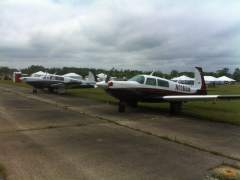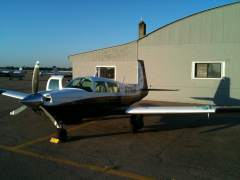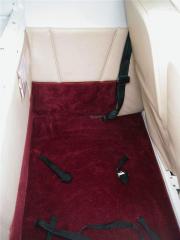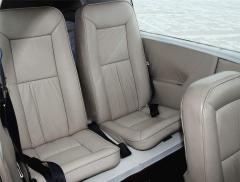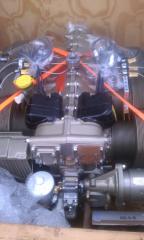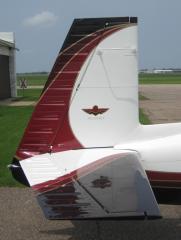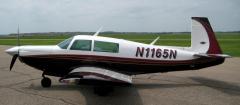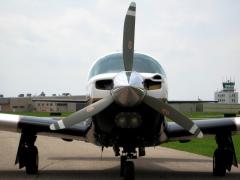-
Posts
3,266 -
Joined
-
Last visited
-
Days Won
15
Content Type
Profiles
Forums
Blogs
Gallery
Downloads
Media Demo
Events
Everything posted by Seth
-
When I purchased my F Model in 2008, the title check came back clean. When I sold it in 2011, there was a hit from a previous lien for a note on the aircraft. It turns out very similar to your that the note had been paid off, but never removed from the title, and I do not know why it turned up when I went to sell since it was from the mid 1990s and was not in my doccumentation from 2008 when I purchased the aircraft. My only thought is that after I purchased the airplane, some old files at the bank I won't mention were found and then sent to the FAA. 2008 was a bad economic year, and maybe an order was given to collect on any loan possible, etc . . . thought this is pure speculation. So, before selling, as I was lucky this bank was still in existance, I walked in, demanded in a respectful manner to see the manager, and then sat in their office for three hours until they handed me a letter stating that the bank no longer had any interest in the aircraft. The deal went smoothly from there. Unfortunatly, the organization that had the claim is no longer in existance, so as stated by others, a judge is going to have to remove it unless someone at the FAA understands and takes care of you as a reasonable person should. Good luck. -Seth
-
When I had my shoulder and knee surgeries in December 2009, I self grounded myself for a period of about three to four months. Once I got use of my arm back to work the Johnson Bar on my F Model, I went up with an instructor to make sure I could actually operate it again. So, the 1967 F model did sit from December until around late March without a flight. In hindsight, I could have asked the MSC on the field to run it for me once a week or at least once a month just to keep the engine working. My Mooney Missile was down for the engine overhaul from the test flight prior to purchase in Mid July 2011 to a few days before pickup to fly home either Sept 30th or Oct 1, 2011. Besides that, flown regularly, maybe sitting once for 20 days, but other than that, flown usually weekly. Sometimes multiple times per week, sometimes missing a week here and there. -Seth
-

pull a cylinder off to view camshaft and lifters?
Seth replied to jetdriven's topic in General Mooney Talk
During my pre-buy for my Mooney Missile in 2011 I had a cylinder pulled too look "inside" due to metal contaminents in the oil filter after a wonderful test flight and after a pretty good prebuy inspection. It was a determination made as per the A&P's recommendation. Turns out on lobe was bad and the lifters were pitted pretty badly. I reduced my offer since an overhaul was in the future (either of the bottom end was needed, but that was good money after bad with the engine time - so it was a full overhaul). I saved a lot of money and immediatly overhauled the engine on purchase. If the metal particles had not been in the oil filter, I'm not sure if I would have pulled the cylinder. I may have simply due to engine time (1550ish on an IO-550 with about 200 hours and a few years since a top overhaul). I was also following the advice of Jason the mechanic based at BBB who was recommended by Bruce Jager to me. Bruce conducted the test flight for me. I did not pull a cylinder on the purchase of a 1967 M20F model in 2008, but it was maintained by the MSC that it was based at and I did trust their opinions as to the health of the plane they maintained. I had very few engine issues (debris in the fuel injectors twice) during 3 years and 500 hours of ownership of the F. It was also a factory overhauled engine at purchase with about 50 hours on it SMOH. Take care, -Seth Update: I relized I may have made a mistake in terminolgy. I had a borescope completed inside the engine, not a cylinder pulled, unless it is the same thing, and I am not sure if it is or not. I know that the mechanic had to remove a cylinder, or removed something in order to get inside the engine to take a look, but he did use some sort of borescope tube as well. -
Great thread - I'm also working on my personal procedures for LOP ops in cruise. My engine is an IO-550, so that is different than your setup. 1. I climb ROP 2. The final cylinder peak is where I worry because my engine starts to run rough due to the first cylinder peaking getting too lean once the final cylinder is only 10 to 20 degrees LOP. Since my engine is only about 60 hours SMOH, I'm now at the point where I can start fiddling with it to see if we can get a more even spread on the GAMIs. That may help, but then again, it does run smooth enough when the last cylinder is at 10 to 20 degrees LOP. 3. During decent I leave the mixture as is but watch temps and adjust if necessary. Also, in the pattern I go ahead and place the mixture to my landing procedures during the GUMPS check. 4. I'm learning that CHT is the big one, but I still watch EGT due to prior training. 5. Not sure yet 6. I've been working on it myself, but having someone who knows how to run an engine lean of peak, just with any newe type of procedure, is always good to fly with. Thanks again for posting this topic - I've learned a lot. -Seth
-
You are very welcome! As you are aware, any of us can talk about airplanes for hours. Glad you too have the avaition bug. Like Rob and the Howells stated, this is a great forum and people here are pretty nice to one another, even when we don't agree on a subject - and it is okay to disagree. Some topics that push hot buttons, so you are aware when you start to learn and ask about them, it's not you they are upset with, just the differing opinions are: 1. LOP / ROP ops (lean of peak vs rich of peak operations - how much fuel is in the engine vs the hottest temperature and pressures internally - you'll learn more about this) 2. Bladders vs Reseal (Mooney's have an issue with the wet wing tanks beginning to seep and leak over time - you can fix it with bladders or resealing the tank - there are strong opinions on both sides for the positives and negatives of both repairs) 3. Politics - amazing how everyone has to get in on these when they are sometimes off topics I'm sure someone will go ahead and mention number 4, 5, and 6. Keep us updated on your flight milestones, ask any questions you need to as you fly more and more, and let us know when you get into the purchasing phase and do find an airframe you're thinking of purchasing - we'll let you know every issue that we notice - for all you know, it may be a plane someone here has owned or looked at during a prebuy. Make sure to pay for a good prebuy inspection. Take care, -Seth
-
Quote: jbs007 Anyone see the aircraft carrier below in the last picture? God bless America!
-
Quote: Comatose They don't often break up in flight, they're very stable, they're good in crosswinds, they climb well and they glide well. Most of them run engines that are on the more reliable side. They're strong in a crash. They all have some sort of autopilot system. I don't know what more you could ask of the plane - the rest is up to you. On the other hand, if you're a newly minted pilot, it will take you 25 to 50 hours to stop being dangrously behind the plane. They're not very tolerant of poor speed control on landing. They're hard to descend and slow down in simultaneously, so you have to start thinking landing about 50 miles out. You have to remember to put the gear down.
-
I went from the fantastic 496 to Aera 560 last October. I loved my 496 but I have to admit that the combination of the 430 and interconnected Aera is very nice. I have the Aera panel mounted vs yoke mounted as I had with the 496. I too was very worried about the touch screen issue, but in the end it was a non-concern. That being said, a lot of the data is entered into the 430 and then automatically loaded in the 560, but there are many functions where I have to use the 560 via the touchscreen. I do like the vertical terrain feature where you can see what lies ahead on your current bearing and if you're going to have trouble at your current altitude. The WX animation is better too, even though the 496 was really good. Reading in sunlight is not an issue. Much better than my ipad. Take care, -Seth
-

Ambassadors: Virginia Festival of Flight 4/28-29
Seth replied to mooneygirl's topic in General Mooney Talk
Alex, Tim, and Larry - sorry I could only make it Sunday - would have loved to have said hello in person on Saturday! -Seth -

Ambassadors: Virginia Festival of Flight 4/28-29
Seth replied to mooneygirl's topic in General Mooney Talk
I'd like to congratulate Mike for organizing a Mooney Ambasadors event at the VA Festival of Flight. Mike arrived on Saturday and I arrived on Sunday. When I arrived, the clouds were at 2200 feet and unfortunately, the weather caused many people to decide not to attend the event. It was obvious that more people came both by car and aircraft in the past. Upon arrival I was able to park next to Mike's 231 and seeing both Mooney's with similar paint jobs (your Mooney looks good Mike) on a mainly deserted parking area did cause quite a few people to come over for a look. The temporarily closed runway we parked on has been packed in previous years wingtip to wingtip on both sides. When I arrived there were maybe eight aircraft. This event has been well attended in the past according to the people there, and the way they had it set up, I'd bet that was true. I just hope funding is not cancelled for all of the food vendors and support staff for next year. We almost took pictures of our two Mooneys from overhead in an R-44 giving rides. That would have been a neat shot (Mike's idea). I'll post some pictures in the next few days on the main page. -Seth -
-
From the album: Mooney Missile 1165N
-
Quote: jetdriven Ross- My former 1967 M20F had bladders (and though I'm a believer in both bladders and wet wings, but that's a discussion for a different thread) that were put in prior to my ownership in the early to mid 90s (so at that point 15+ years with no issue) but it was the smaller bladders - 27 per side or something like that but only 25 usable - so about 50 useable gallson. At 11 gallson per hour max, that would be 4.5 hours of flight. I did not have full power the entire time in order to extend range, and was leaned pretty well, but I knew I had to get on the ground. I had less than 30 minutes of flight remaining (I'm sure of that) and vowed never to let that happen again. So, I didn't have 1.5 hours left, I had at best .5, and after the Top off, if memory recalls, though I didn't run either tank dry, I didn't have more than a few gallons left in each wing. It was deep into the 40 gallons, if not closer to 44 or 45 on the top off. I'd have to check my records. The new Missile, with 98 gallons, and at a lean of peak setting of about 12 gallons an hour at 170 knots, that's a LONG distance flight in 0 wind conditions. I do not plan to test that. I tend to fly ROP currently as I'm still working on getting the engine smooth at LOP far enough from peak to make that work without negative vibration (again, topic for another thread) but even at 15-17 gallons per hour ROP, 98 gallons lasts a long time. If anything, I tend to not fuel up as much and thus do not carry the full 98 unless I find cheap fuel to top off. I find that I fill up th the mains at 62 useable now more often then filling up the entire 98. It does amaze me that I'll put 70+ gallons in the wing at the pump, when in the F model I'd put in 35+ on a big day. Sticker shock for sure, espeically with fuel prices these days. -Seth
-

S-TEC 30 With Altitude Hold For Sale
Seth replied to Thumper's topic in Avionics / Parts Classifieds
Quote: rbridges sounds like a really great price for the STEC. btw, why is your F being parted out? -

New Owner Questions - ROP/LOP & MP/RPM Settings
Seth replied to helojunkie's topic in Mooney Bravo Owners
Hello Richard and welcome to Mooney Space! Congratulations on the purchase of your Bravo. As others have stated, do not run at 50 ROP - that will lead to a premature top overhaul. -Seth -

S-TEC 30 With Altitude Hold For Sale
Seth replied to Thumper's topic in Avionics / Parts Classifieds
Quote: JimR I'd make sure that the STC is transferable and not airframe specific before purchasing this with the intention of installing it in a certificated aircraft. I'm not saying that it is not, but this is something that you'll want to nail down prior to purchase. Jim -
Quote: Hank I know what you mean about getting uncomfortable. I just flew 4.4 hours [thank you, headwinds!], leaving with 50 gals in my 52-gal tanks. I ran the left tank low enough that I was getting nervous, counting time on my fingers. When I landed, I still had 10 gals in the right tank. It's no fun looking at 2-digit groundspeeds . . . This was a long ways from my longest-distance flight, but it was certainly my longest duration.
-
Quote: Shadrach
-
Mike and all- As for cancelling IFR in Class B. I have had to deal with that at times as well when I used to fly out of Freeway (W00) and not as much to an extent, but also techincally when flying into (GAI). At Freeway, the Bravo airspace begins at 1500 msl, and at KGAI it is 3500 msl. This is the BRAVO around DC for BWI, DCA, and IAD (and technically Andrews AFB as well). Since these airports are still within the SFRA, you're still in communication with controllers after cancellation, but that does not matter for the example I'm about to give. I realized the same question during my IFR training - can you cancel IFR when in class Bravo - the answer I recieved from my CFII, and really never bothered to double check, so I guess I'm doing that here, was: Once you cancel IFR in class Bravo, you are allowed to remain in class Bravo. However, once you exit class Bravo airspace, you cannot reenter class Bravo without a new class Bravo clearence. Example. I am at 2500 feet, direct Freeway (W00) on an IFR flight plan and I now have the field in sight. I make my call to Potomac Approach that I have Freeway in sight and will cancel IFR at this time. They will state that cancellation is recieved, keep my beaco code (because I'm in the SFRA - we never squak 1200) frequncy change approved. That point I'm in Class Bravo, within 8 or so miles of Freeway (W00) and now on the Freeway common traffic advisory frequncy. However, I'm still in the Bravo. I begin my decent to the airport, and once I cross 1500 msl in the decnet, I'm out of the Bravo, in the VFR space under the Bravo shelf, and cannot reenter the Bravo. Techincally, I guess I could have stayed in the Bravo, and then spiraled down to the field once I was over it at 2500, but again, that is not what is normal, and I porbably woudl have stated my intentions to the controllers before switching to the common traffic advisory frequency. Just Sunday coming back from the VA Festival of Flight (I'll post on that in a bit) I had an IFR plan and was in the lower Bravo heading to Gaithersburg (KGAI). They had me at 3000 feet as I neared KGAI but I was still in the 2500 foot floor area for the Bravo. When I had the field (it was a bit more than 10 miles out) I cancelled IFR in the Bravo, got my usual instructions, and simply flew out of the Bravo toward KGAI (the shelf soon raised to 3500 msl so I was only within the Bravo for a short period) but was able to stay higher and out of the bumps as long as I could, and I'm sure my passenger was happy about that. Let me know if I'm breaking rules, and hopefully this will help shed some light. It seeems to be a common practice here in DC, or at least near W00 - the guys who taught me IFR. -Seth
-
I both purchased and sold my '67 F for more than that. Either it is a must sell for personal financial reasons, somthing is wrong, or the market price of our beloved Mooney aircraft, though we thought had stabilized somewhat, is in a free fall again. With the 201 Clone that is is, with electric gear and flaps, 430, portable garmin, interior, paint, and mid-time on engine and airframe, I'd think $65-$85 depening of course on the unknown issue. Maybe the seller just wants to sell quickly - very quickly. -Seth
-
When I purchased my Mooney Missile, I had Tim Lundquist the broker arrange the demo flight and prebuy for me. My demo pilot was indeed Bruce Jager, and I agree there are few instructors and Mooney pilots out there with more knowlege than Bruce - a pure pleasure to fly with and have demo an airplane. Jason Dorcher of Jed-Aire Aviation (his company) was arranged to conduct the prebuy and he was a former employee over at Wilmar (I think he ran the shop for Bruce at one point). Jason is a ture genuine person and his quality and workmanship are top notch. If I did not have an MSC nearby, or even if I did and Jason were local, he's be my A&P of choice. I'm very confident in him, and with his easygoing quiet confidence, he'll let you know the true story of what is going on inside your airplane. He is based a short flight away from Wilmar at Benson, KBBB (26 nm). He will give you an independent view if you are uncomfortable with the Wilmar association with Wilmar both maintaining and conducting the annual on the aircraft, however, I would trust Wilmar in a heartbeat. Jason, Tim, and Bruce were all impressed with the Missile, but Jason did find that the engine was making metal - that caused me to reduce my offer significantly and have the engine overhauled at purchase. And believe me, the engine was running extrememly smoothly with a lot of power and speed before the oil was drained, and Jason found the metal in the oil filter. Jason's office number is 320-843-4461. Feel free to say that I suggested him as a outside opinion for you to contact regarding this aircraft. If you need other suggestions, as menioned earlier in this post, I would trust Bruce Jager's advice on who else to speak with. Also, you can alwasy as Tim Lundquist, who operates Statgic Aircraft, www.strategicaircraft.com - 612-220-3963. He's probabaly reccomend Bruce and Jason. Last but not least, I flew last July to and from Maryland to Minnesota over a weekend to test fly my current Missile in my former F model - the distance was 920 nm each way. Well worth the trip. I also used some points to fly to Dallas for a prebuy on an aircraft I did not purchase about a month and a half earlier - also worth the trip and the prebuy to say "no deal." Good luck with your purchase! -Seth
-
SOUNDS AMAZING - Glad you had such a great trip!! I'm planning to fly to Reno from the east coast in September. When I flew accross the country in 2010, I had the same thoughts as you - about 40 hours total flying, but I didn't spend enough time in each location - always build in more time relax at your destination. -Seth
-

Cabin Nose Gear Faring Screws-Be Careful
Seth replied to scottfromiowa's topic in Vintage Mooneys (pre-J models)
-
Without stops - in the 1983 Mooney Missile from KISM to KGAI in a little over four hours. Longest point to point Distance. Without stops - In the 1967 Mooney M20F - forget where but it was just over 4.5 hours, and I landed with not a comfortable amount of fuel on board - Longest time aloft. With stops - Summer 2010 in my former 1967 M20F - Flew from the east coast to west coast and back - circled the country. KGAI - Maryland to NC (business lunch) to OK (business), to Dallas TX (business dinner), to Victoria, TX (business), to South Padre Island for Fourth of July with the old gang from college. From there to West Texas (fuel), then Pheonix Arizona (goodyear field - lunh with friend), and from there to Santa Monica Airport to visit my sister for a few days. We flew out to Catalina for a late lunch one day. From there I headed to PDX - Oregon for the evening with an old college frined, and the next morning left for Bozeman, MT (fuel and lunch), and then to Rapid City Falls for Mt. Rushmore. The next morning I went to Luverne, MN, where the field was named after a former colleague and family friend of mine, Quentin Annenson (a fighter pilot's story that aired on PBS a few times), and then to Flying Cloud in Minneapolis, MN for a birthday weekend with a friend (his BDay) and business meetings on Monday and Tuesday. I flew home to Maryland with one stop for fuel that Tuesday evening. It was something like 40 hours of flying over two weeks - it was fabulous.
-
John- I was there too! Sorry we missed meeting up. Good information at the meeting. I'm the guy that asked about picking up your SFRA squak code before departing toward the SFRA (and of course, not actually entering until given permission by Potomac Approach). It was a good meeting with quite a few people present from many facets fo the FAA. We had an FSDO represtentative, FAST team represetnative, Tower Manager, controllers, Tracon Controlers - it was well done - not enough seats though. -Seth



